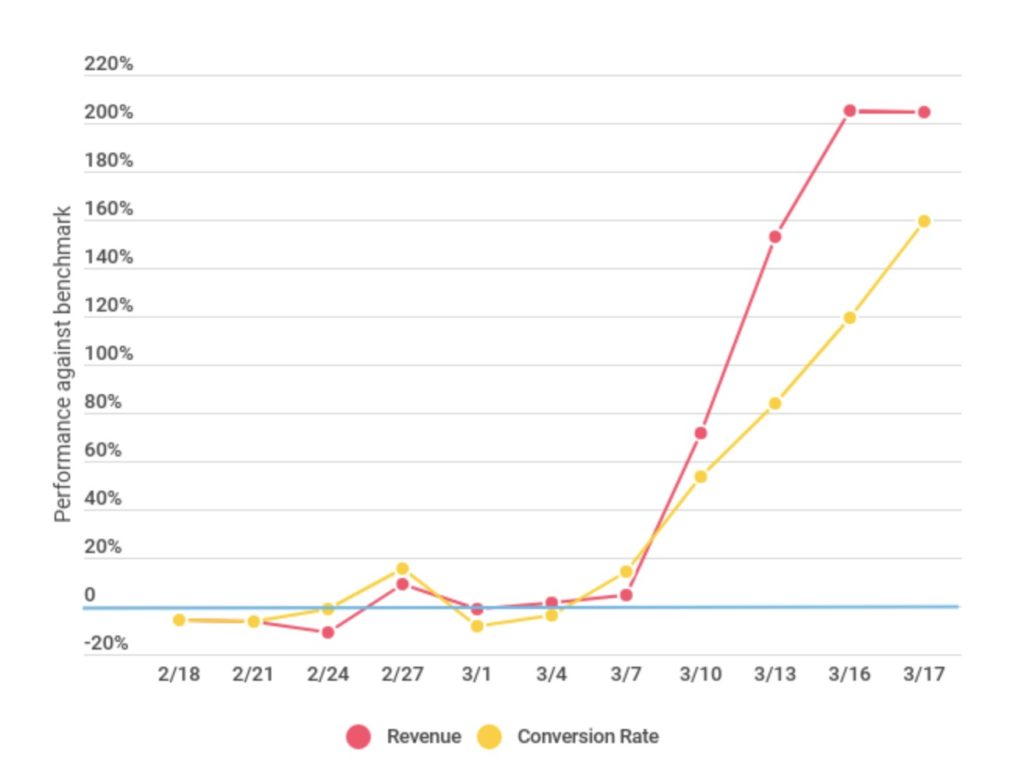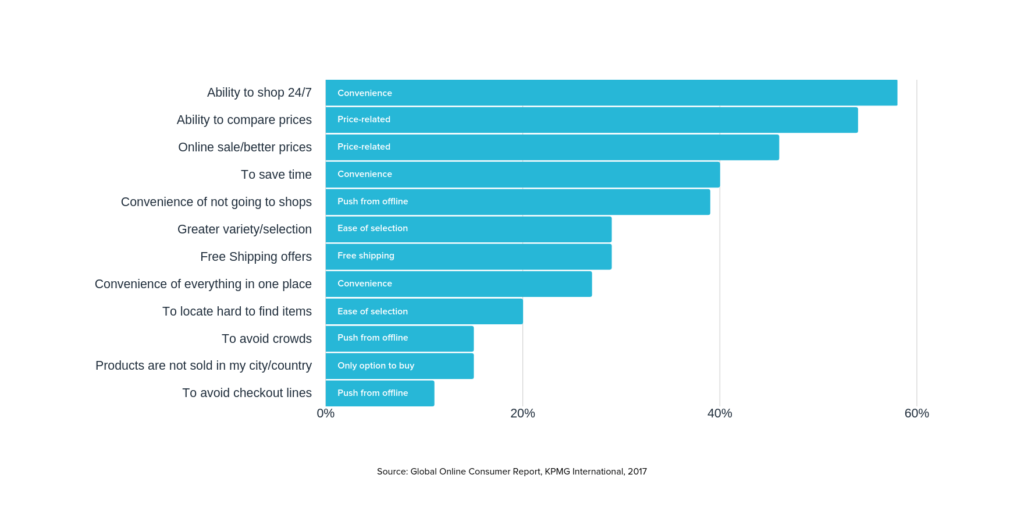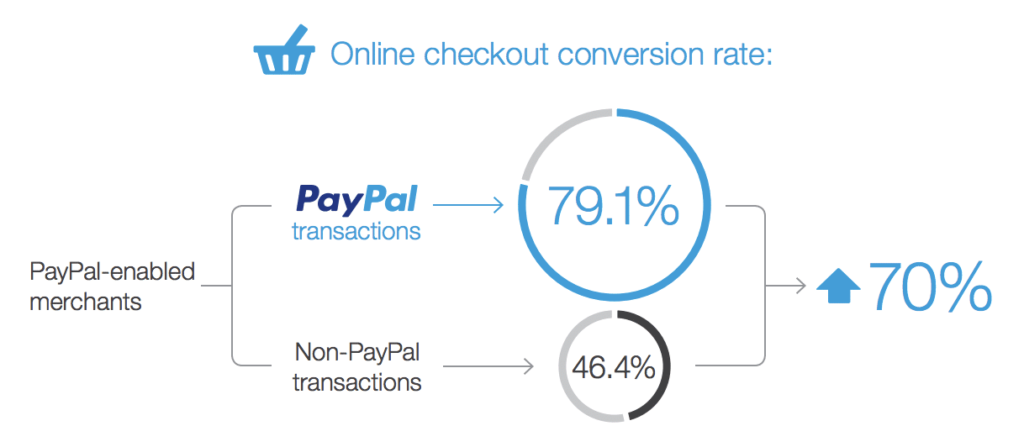
Once again, it’s the roaring ‘20s – and it’s going to be a huge decade for ecommerce growth. According to the latest stats, worldwide retail ecommerce sales will reach $4.9 trillion by 2021 and we’re looking at an average increase of 16% each year.
Needless to say, there’s never been a better time to be (or become) an ecommerce business owner.
We’re off to a great start to the decade – so what else do we have to look forward to this year? In this article, we share the top 10 ecommerce growth statistics you need to know, so you can get prepped and get keen for a huge year in sales. Read on!
#1. It’s estimated that there will be 2.05 billion global digital buyers in 2020

Image: Oberlo
There are 7.7 billion people in the world and according to recent stats, 2.05 billion are shopping online – which means 25% of the earth’s population is shopping online.
This number is rising, too – in 2021, it’s expected 2.14 billion people will be shopping with online retailers.
That’s a lot of potential customers and a whole world of opportunities for ecommerce business owners, both old and new. There’s never been a better time to open an online store.
#2. Subscription services have seen a surge in popularity amid COVID-19
COVID-19 has had a huge impact on how customers shop. The amount of people allowed to gather in public has dropped from thousands, to hundreds, to ten, to just two – so, out of fear and necessity, customers are choosing to shop online rather than visit a traditional brick-and-mortar store.
Surprisingly, ecommerce sales haven’t skyrocketed amid COVID-19 but there are a few notable exceptions. For example, subscription and convenience services have had a massive boost in both revenue and conversion rate.

Image: Big Commerce
This includes weekly/monthly meal delivery services and digital streaming services like Netflix. This comes as no surprise – most of the time, people aren’t allowed outside and have more time to catch up on the latest TV shows.
If your business has the potential to expand your service to provide a regular subscription – look into it!
#3. China has the largest market of ecommerce in the world
China has topped the list of ecommerce markets worldwide – a $672 billion market, smashing America out of the water at $340 billion and the United Kingdom at $99 billion.
Nielsen’s Global Connected Commerce report shows the breakdown of industries, too – South Korea dominates fashion (77%), beauty products (66%), non-food household groceries (52%), packaged grocery food (51%), and fresh groceries (37%).
#4. Credit card is still the top choice of payment method worldwide
Despite the convenience of Afterpay and Zippay, credit cards are still the preferred (or most common) payment method around the world. According to recent stats, 53% of online transactions are made with credit cards, followed by digital payment systems at 43%.
The takeaway – make sure you’ve got a secure checkout process for all payment types and shout it from the rooftops to develop trust between you and your customers.
#5. The number one reason people shop online is that they’re able to shop at all hours of the day

Image: Oborlo
Like we said earlier, shopping online is fun, quick and convenient – but the main reason ecommerce is booming comes down to the ability to shop at all hours of the day (or night… you never know when the urge to buy a new running jacket is going to strike).
According to the Global Online Consumer Report, almost 60% of respondents said they shop online because online stores are open 24 hours. The next most common responses: the ability to compare prices, find a better deal, and to save time.
The key takeaway here: make sure the shopping experience for your customers is simple and convenient. You might consider “quick buy” options for customers to make purchases on the fly, offer flexible payment methods, and allow shopping on other platforms like Instagram.
#6. 65% of shoppers look up price comparisons on their mobile device while in a physical store
Even customers who shop in-store are opting to shop online. According to the latest stats, 65% of shoppers look for price comparisons on their mobile devices while shopping in-store to find out if they can get a better deal.
This is super convenient for ecommerce business owners because there’s a simple way to take advantage of the situation. Using Google Shopping, you can appear in Google’s search results when customers are looking for the products you’re selling.
For example, if a customer is shopping for novelty moon lamps in-store and wants to compare prices, they can search “novelty moon lamp” and your products will appear at the top of search results.
Google Shopping is also pay-per-click, like Google Ads, so even if customers don’t check out with you, you’re still working on spreading brand awareness.
#7. 85% of consumers conduct online research before making a purchase online
In the same vein, customers are now doing more research than ever before prior to making a purchase.
85% of customers need to know the details before checking out – they need to know they’re getting the right product at the right price, so you need to make sure your product pages are detailed, emotive, have all the facts and specifications, and lots of high quality images from all different angles.
This will provide reassurance for the customer.
#8. PayPal transactions have 70% higher checkout rates than non-Paypal transactions

Image: Paypal
In 2020, a good conversion rate comes down to three things – good visuals (design and images), fast website load time (no waiting around for images and pages to load), and ease of payment.
Of course, positive reviews, recommendations, and social proof all contribute to a great customer experience – but we’ve seen some high conversion rates thanks to flexible payment methods like Paypal.
According to recent stats, ecommerce stores who offer Paypal have a 70% higher conversion rate than those who don’t. Paypal provides a higher level of transaction security, leaving customers feeling more comfortable with their purchase and trusting of the seller – so, if you aren’t already offering Paypal, get on it!
#9. 80% of people stop doing business with a company because of poor customer experience
When it comes to transactions, trust is paramount. Once customer trust has been lost, it’s almost impossible to get it back – and around 80% of customers will not return to your online store if their experience was negative.
In 2020, improving the customer experience and providing stellar customer service should be your number one priority. Aim for accurate shipping quotes and timelines, fast website speed, and live chat for around the clock service. The internet never sleeps – and your customer service shouldn’t, either.
#10. 64% of customers find customer experience more important than price
According to the Guardian, the customer experience will be more important than price and product in 2020.
Online business owners lose billions in revenue each year due to poor customer service, so again, it’s never been more important to look after your customers and ensure their experience is memorable (in a positive way, of course).
Welcome to the roaring ‘20s – it’s going to be a big one!
In 2020, we can expect some huge ecommerce growth. The stats don’t lie – and the time is ripe to start (or improve) an ecommerce business.
Whether you’re a brand new online business owner, thinking of starting a business, or a seasoned ecommerce entrepreneur, we’re here to help. We offer simple, streamlined courier booking and postage services, so you can keep on improving the customer experience, offer super fast shipping, and watch sales stream through into your bank account.